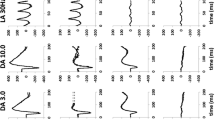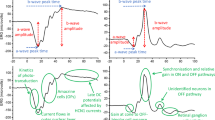Abstract
Electroretinography (ERG) is a foundational method for assessing visual system physiology, but accurate ERG can be time- and labor-intensive, often involving manual adjustment of the wavelength and intensity of light stimuli and real-time comparison of physiological responses to inform those adjustments. Furthermore, current approaches to ERG often require expertise beyond that necessary for the electrophysiological preparation itself. To improve both the efficiency and accessibility of ERG, we designed an automated system for stimulus presentation and data acquisition. Here, we test this novel system’s ability to accurately assess spectral sensitivity in the well-characterized visual system of the crayfish Procambarus clarkii using three approaches: the first, based on response magnitude, maximizes efficiency; the second is a well-established method we use to further validate our efficient approach’s accuracy. Third, we explore the potential benefits of extensible automation using a method assessing the interplay between temporal acuity and spectral sensitivity. Using our system, we are able to acquire accurate results in ERG experiments quickly (testing the entire visible spectrum in 8 min, 30 s using our response magnitude approach). Moreover, data collected via all three methods yielded results consistent with each other and previous work on P. clarkii.



Similar content being viewed by others
Availability of data and materials
The data that support the findings of this study are available from the corresponding author, LTH, upon reasonable request.
Code availability
All code involved in the automated ERG system is open-source and can be found at lukehavens.com/projects/electroretinography/. Code performing common functions such as visual pigment curve-fitting and statistical analyses are available from the corresponding author, LTH, upon reasonable request.
References
Beckmann H, Hering L, Henze MJ, Kelber A, Stevenson PA, Mayer G (2015) Spectral sensitivity in Onchyophora (velvet worms), phototactic behaviour and opsin gene expression. J Exp Biol 218:915–922
Cronin TW, Johnsen S, Marshall J, Warrant EJ (2014) Visual ecology. Princeton University Press, Princeton
Cummins D, Goldsmith TH (1981) Cellular identification of the violet receptor in the crayfish eye. J Comp Physiol 142:199–202
Cuthill IC, Allen WL, Arbuckle K, Caspers B, Chapelin G, Hauber ME, Hill GE, Jablonski NG, Jiggins CD, Kelber A, Mappes J, Marshall J, Merrill R, Osorio D, Prum R, Roberts NW, Roulin A, Rowland HM, Sherratt TN, Skelhorn J, Speed MP, Stevens M, Stoddard MC, Stuart-fox D, Talas L, Tibbetts E, Caro T (2017) The biology of color. Science 357(6350):eaan0221
de Souza JM, Devoe RD, Schoeps C, Ventura DF (1996) An AC constant-response method for electrophysiological measurements of spectral sensitivity functions. J Neurosci Methods 68:203–210
Frank TM (2003) Effects of light adaptation on the temporal resolution of deep-sea crustaceans. Integr Comp Biol 43(4):559–570
Goldman DE (1943) Potential, impedance, and rectification in membranes. J Gen Physiol 27(1):37–60
Kennedy D, Bruno MS (1961) The spectral sensitivity of crayfish and lobster vision. J Gen Physiol 44(6):1089–1102
Kingston ACN, Lucia RL, Havens LT, Cronin TW, Speiser DI (2019) Vision in the snapping shrimp Alpheus heterochaelis. J Exp Biol 222(21):jeb209015
Kong K, Goldsmith TH (1977) Photosensitivity of retinular cells in white-eyed crayfish (Procambarus clarkii). J Comp Physiol 122:273–288
Land MF, Nilsson D-E (2012) Animal eyes. Oxford University Press, New York
Lessios N (2017) Using electroretinograms and multi-model inference to identify spectral classes of photoreceptors and relative opsin expression levels. PeerJ 5:e3595
McComb DM, Frank TM, Hueter RE, Kajiura SM (2010) Temporal resolution and spectral sensitivity of the visual system of three coastal shark species from different light environments. Physiol Biochem Zool 83(2):299–307
Nernst W (1889) Die elektromotorische Wirksamkeit der Jonen. Z Phys Chem 4U(1):129–181
Rocha FA, Gomes BD, Silveira LC, Martins SL, Aguiar RG, de Souza JM, Ventura DF (2016) Spectral sensitivity measured with electroretinogram using a constant response method. PLoS ONE 11(1):e0147318
Stavenga DG (2010) On visual pigment templates and the spectral shape of invertebrate rhodopsins and metarhodopsins. J Comp Physiol A 196(11):869–878
Telles FJ, Lind O, Henze MJ, Rodríguez-Gironés MA, Goyret J, Kelber A (2014) Out of the blue: the spectral sensitivity of hummingbird hawkmoths. J Comp Physiol A 200:537–546
Vogel G (1956) Verhaltensphysiologische Untersuchungen über die den Weibehenbesprung des Stubenfliegen-Männchens (Musca domestica) auslösenden optischen Faktoren. Z Tierpsychol 14(3):309–323
Wagman IH, Gullberg JE (1942) The relationship between monochromatic light and pupil diameter. The low intensity visibility curve as measured by pupillary measurements. Am J Physiol 137(4):769–778
Waller AD (1900) On the retinal currents of the frog’s eye, excited by light and excited electrically. Phil Trans B 193:123–163
Warrant EJ (1999) Seeing better at night: life style, eye design and the optimum strategy of spatial and temporal summation. Vision Res 39(9):1611–1630
Warrington RE, Hart NS, Potter IC, Collin SP, Hemmi JM (2017) Retinal temporal resolution and contrast sensitivity in the parasitic lamprey Mordacia mordax and its non-parasitic derivative Mordacia praecox. J Exp Biol 220:1245–1255
Acknowledgements
For their advice on this project, the authors thank Christine Bedore and Dan Chappell. LTH also thanks Dick Vogt for initial training in the field of electrophysiology.
Funding
Support for the authors was provided, in part, by IOS Award no. 1457148 from the National Science Foundation (to DIS), as well as a Magellan Scholar Award from the University of South Carolina and a Science Undergraduate Research Fellowship from the South Carolina Honors College (both to LTH).
Author information
Authors and Affiliations
Contributions
LTH designed and built the electroretinography apparatus, conceived of and programmed the automated electroretinography protocols, and collected spectrally influenced temporal acuity and sensitivity-converted response data. ACNK collected response magnitude data. DIS oversaw the project. All authors contributed to analyzing data and drafting the manuscript.
Corresponding author
Ethics declarations
Conflict of interest
The authors declare no conflicts of interest.
Ethics approval
We followed all applicable rules and regulations for the care of crustaceans in the United States.
Consent to participate
Not applicable.
Consent for publicatio.
Not applicable.
Additional information
Publisher's Note
Springer Nature remains neutral with regard to jurisdictional claims in published maps and institutional affiliations.
Rights and permissions
About this article
Cite this article
Havens, L.T., Kingston, A.C.N. & Speiser, D.I. Automated methods for efficient and accurate electroretinography. J Comp Physiol A 207, 381–391 (2021). https://doi.org/10.1007/s00359-021-01476-4
Received:
Revised:
Accepted:
Published:
Issue Date:
DOI: https://doi.org/10.1007/s00359-021-01476-4




